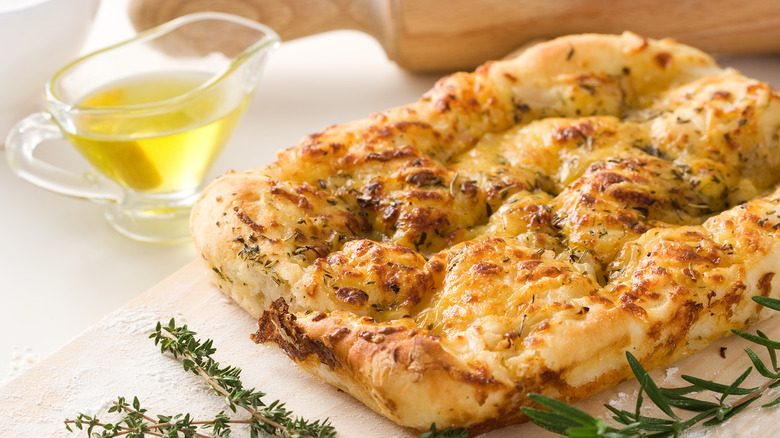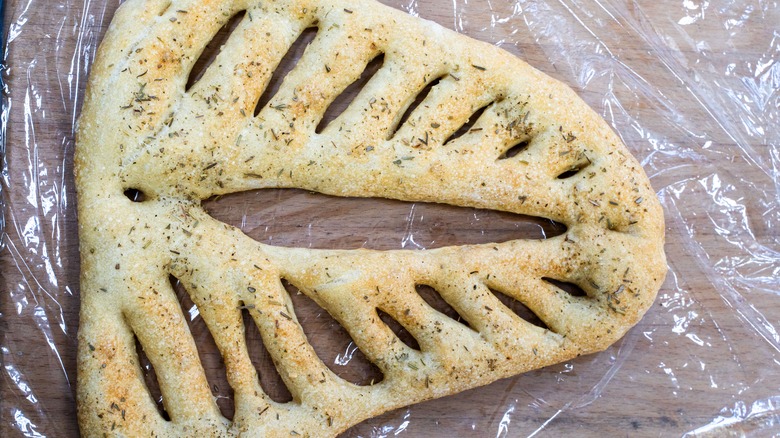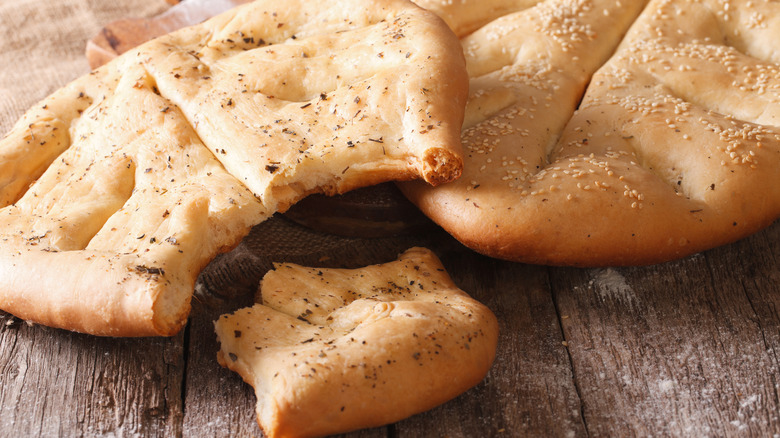Fougasse Vs Focaccia: What's The Difference Between These Breads?
The world is full of unbelievably delicious flatbreads — each made from a simple mixture of flour, water, and salt, but which pack entirely different flavors and textures. Take Italy's renowned focaccia and France's fougasse, for instance. Both start off from a similar dough that's made using flour, yeast, oil, and salt, and yet, are two entirely different breads. The difference, it turns out, is in how the dough for the two is shaped and baked.
Focaccia's dough is laid onto a round or a rectangular sheet pan, poked with fingers to create tiny dimples, and generously drizzled with olive oil which then gathers in these little craters. Once baked, the oil-rich dough yields a bread that has a fabulously soft, moist, spongy, and springy texture with crisp edges and an airy crumb — perfect for dipping in coffee for a signature Italian experience.
On the flip side, the dough to make the French flatbread fougasse (pronounced as foo-gehs-uh) is sculpted with hands into an almost ovular shape. A blade is used to slash the dough and create holes in branch-like patterns, giving fougasse the appearance of a leaf or a shaft of wheat. This dough is traditionally placed on a stone rather than a sheet pan and then baked. The result is a distinct-looking bread that's far more crisp and crackly than focaccia, and which has more crust than crumb thanks to the gaps created between the dough.
Fougasse and focaccia are descendants of the same ancient bread
Fougasse is often referred to as focaccia's French cousin, and for good reason: they do share the same ancestor, after all. Both fougasse and focaccia are descendants of an ancient Roman bread named after the Latin phrase panis focacius, which refers to bread of fire. With time, the bread transformed into focaccia in Italy, where it was ripped apart, dunked into soups, and eaten as a cheap meal by hungry peasants, laborers, and the poor.
As Romans traveled across Europe, so did their panis focacius. It eventually reached Southern France where it came to be known as fougasse. At the time, fougasse was used by bakers merely to check the temperature of their wood-fired ovens. How quickly fougasse baked helped them gauge how hot the oven was. Interestingly, this practice gave birth to the phrase il ne faut pas brûler la fougasse, meaning you must not burn the fougasse. The resulting warm, crusty bread was then eaten as a snack by the bakers.
As years progressed, fougasse emerged as a bread in its own right. More ingredients (both sweet and savory) were added to the simple dough, and fougasse became especially popular in Provence. In fact, it enjoyed great importance in religious ceremonies, as locals believed that fougasse's shape — which resembles that of wheat shafts — could ward off evil spirits.
The toppings used in fougasse and focaccia, and how the two breads are eaten
Fougasse and focaccia's most distinguishing factors are their appearance and texture. In terms of toppings, however, the two breads are more similar than not. Both fougasse and focaccia can be topped with something as simple as salt, or an array of herbs, meats, cheese, and veggies. They both have sweet versions too, which come with sugar, honey, nuts, spices, fruits, and citruses — though fougasse often features orange flower water as well.
Thanks to fougasse's popularity in Southeast France, however, it is often sprinkled with savory herbes de Provence, which includes the likes of thyme, rosemary, and sometimes even lavender. It's also common for the olive oil used inside its dough to be swapped with butter in the summers, or with milk during Shavuot – a Jewish holiday when eating dairy items is encouraged. Focaccia's exact ingredients too differ from region to region. For instance, in Southern parts of Puglia, boiled potatoes are added to focaccia's dough to produce an even softer bread, which is then topped with cherry tomatoes and the occasional black olive.
Both breads can be eaten much the same way, but consider this: Fougasse's superior crustiness means that it can withstand a dunk in hot liquids like soups and stews without losing its crisp texture much better. On the flip side, focaccia's soft sponginess makes it better suited for sandwiches. So, it all depends on how you'd like to enjoy the bread.



